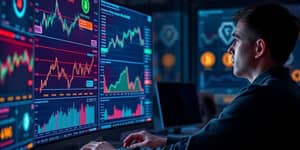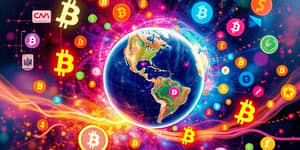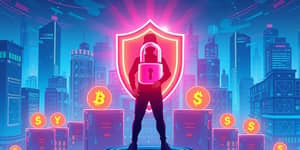The rise of non-fungible tokens (NFTs) has reshaped the way we conceive value, ownership, and creative expression. Once a niche digital curiosity, NFTs have stormed into mainstream financial conversations, offering both thrilling opportunities and sobering lessons. Whether you’re an artist, collector, investor, or simply curious, understanding the financial implications of NFTs is key to navigating this ever-shifting landscape.
Understanding the Basics of NFTs
NFTs are unique digital certificates stored on a blockchain that distinguish one item from another. Unlike cryptocurrencies such as Bitcoin or Ethereum, which are interchangeable, each NFT carries its own metadata and provenance. This groundbreaking mechanism unlocks blockchain-based digital representations of assets, allowing artists and entrepreneurs to tokenize everything from digital art to virtual real estate.
By embedding ownership records into a decentralized ledger, NFTs create a transparent chain of custody. Buyers can verify authenticity and rarity with minimal friction, while creators can program royalties into secondary sales. This model has led to unprecedented creative freedom, but it also introduces novel financial dynamics and risks.
Paths to Wealth Generation with NFTs
Many early adopters have profited by recognizing trends, investing in promising collections, or simply riding market momentum. However, sustained success often requires strategic positioning, technical insight, and community engagement. Below are the primary strategies for generating income through NFTs:
- Flipping: Purchase undervalued NFTs and sell at a premium, capitalizing on hype cycles.
- Content Creation: Mint original art, music, or multimedia assets, offering collectors exclusive access.
- Play-to-Earn Gaming: Earn NFTs through gameplay achievements, then trade them on marketplaces.
- Staking & Fractionalization: Lock NFTs in protocols for rewards or allow fractional ownership to unlock new income streams for creative entrepreneurs.
Each method carries its own risk profile and required skill set. Flipping demands market agility and trend analysis, while content creation hinges on artistic talent and audience-building. Play-to-earn models bridge entertainment and finance, inviting gamers to monetize their time and skill.
Navigating Risks and Market Challenges
Despite success stories, the NFT sector is notorious for volatility. Prices can skyrocket overnight and collapse just as quickly. Many buyers have found themselves holding assets that once traded for millions but now lack liquid markets. Understanding these risks is vital for any investor:
- Volatility: The volatile nature of these digital assets can lead to dramatic gains and losses within days.
- Fraud & Counterfeiting: Phony listings, rug pulls, and stolen assets flourish in a semi-anonymous ecosystem.
- Liquidity Crunch: Without sustained demand, NFTs can become unsellable, trapping capital indefinitely.
- Tax & Compliance: Capital gains, reporting requirements, and evolving regulations can complicate holdings.
Investors must exercise due diligence, verify smart contracts, and engage with reputable communities. Diversification remains crucial; avoiding a single point of failure can protect portfolios against sudden market reversals.
Real-World Applications: Beyond Digital Art
While art and collectibles dominate headlines, NFTs are rapidly permeating broader financial infrastructures. Institutions are exploring tokenized bonds, collateralized lending, and royalty payments facilitated by smart contracts. This trend hints at a future where virtually any asset—from real estate to intellectual property—can be fractionalized and traded seamlessly.
Major banks and fintech firms are piloting NFT-based solutions for asset transfer and custody. By bridging traditional finance and decentralized protocols, they aim to unlock trillions in current illiquid holdings. As this convergence accelerates, NFTs may evolve into fundamental building blocks of a new digital economy.
Evolving Regulations and Compliance
Regulatory bodies around the world are grappling with how to categorize NFTs. Are they securities, commodities, or simply digital collectibles? Recent inquiries by the U.S. Securities and Exchange Commission (SEC) and other agencies have intensified scrutiny. Simultaneously, self-regulatory groups within the NFT community are proposing best practices to stave off heavy-handed interventions.
Proactive compliance can become a competitive advantage. Platforms that integrate know-your-customer (KYC) protocols, transparent royalty distribution, and tax reporting tools are likely to attract institutional clients. As governments are exploring formal standards for compliance, early adopters of robust frameworks will stand out in an increasingly crowded market.
Emerging Trends and Future Outlook
The NFT landscape of 2025 is characterized by relentless innovation. From AI-generated collections that adapt to market sentiment, to hybrid experiences linking physical artifacts with digital twins, the frontier keeps expanding. Key trends to watch include:
- AI-Driven NFT Creation: Algorithmic art that evolves based on user interactions.
- Real-World Asset Tokenization: Fractional ownership of property, art, and commodities.
- Metaverse Integration: Interoperable digital worlds where NFTs serve as passports and assets.
- Play-to-Earn Evolution: Communities forming around shared economic incentives and governance.
These developments promise to deepen user engagement and unlock novel revenue streams. Yet they also underscore the importance of responsible innovation, balancing speculative excitement with lasting utility.
Key Market Statistics at a Glance
Final Insights: Speculative Mania or New Paradigm?
NFTs sit at a crossroads between financial experiment and lasting innovation. For creatives, they offer direct revenue channels and eternal digital provenance. For investors, they present tantalizing gains alongside steep risks. Whether NFTs mature into foundational elements of a decentralized economy or retreat as a speculative fever remains to be seen.
As you consider integrating NFTs into your portfolio, reflect on your risk appetite, long-term goals, and ethical stance. Embrace continuous learning, engage with diverse communities, and remain vigilant against scams. In doing so, you position yourself to seize opportunity while safeguarding your wealth.
Ultimately, NFTs challenge us to rethink the nature of ownership, creativity, and value exchange. If harnessed thoughtfully, they could herald an opportunity for responsible innovation and growth that reshapes our financial landscape for generations to come.
References
- https://www.investopedia.com/pros-and-cons-of-investing-in-nfts-5220290
- https://news.shib.io/2025/04/03/achieving-financial-independence-through-nfts-is-it-a-viable-strategy/
- https://www.gdswealth.com/insight/what-in-the-world-are-ntfs
- https://due.com/wealth-opportunities-nfts/
- https://www.epam.com/insights/blogs/nfts-is-the-world-of-finance-about-to-go-virtual-pt-2
- https://www.scb10x.com/en/blog/nft-market-2025-update-web3-games-regulation
- https://www.techtarget.com/whatis/feature/5-business-use-cases-for-NFTs
- https://bluetoad.com/article/What+the+Rise+of+NFTs+Means+for+Advisors/4192903/734552/article.html










